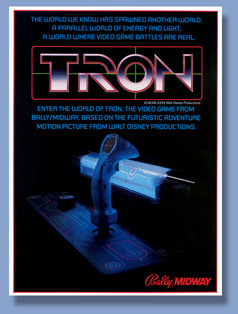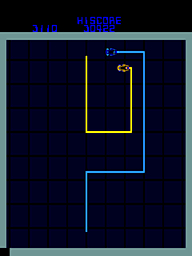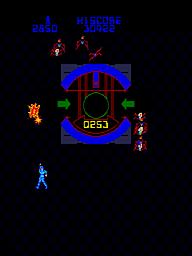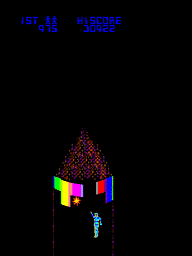 |
|||||||||||
![]()
Tron - the Arcade Game
 Bally/Midway 1982 (KLOV entry)
Bally/Midway 1982 (KLOV entry)
Reviewed by Dave Dries
In preparing to review what may have been the epitome of the video game art for 1982, I realized that many of my thoughts on the game were colored by seeing it in the context of a classic 80's arcade environment. The dark, mysterious, noisy game that emitted the blue glow and stood proudly at the end of the row of video games.
So I thought maybe I should take an approach similar to how the big video game magazines do it. I'll review it based on its gameplay, sound, graphics, and overall value for the money. But for a 20 year-old game that only cost a quarter to play it'd be difficult and probably unfair to judge it by today's criteria.
Then I had a brainstorm. I'd review it based on the opinions of a panel of specially appointed judges. The judges will be younger people (younger than me) and review it from an uncluttered point of view. I didn't have to go far to find my judges. As I was at work while I was preparing this (what...like I'm gonna do this on MY time?) I thought I'd ask some of my coworkers here in the design dept. Joe, the oldest of the judges, was 10 when Tron was first unveiled. Jose, the youngest, was only 4 when Tron made its debut and Josh was 5 years-old in 1982.
Because I don't have access to fancy joysticks and gamepads at work, as I fired up MacMAME on my G4 and loaded Tron I tried to explain how the controls worked. Thats the first hint I had that maybe this wasn't a good idea. As the original game used a flight-grip style joystick with a trigger and a spinner control it's nearly impossible to emulate properly with a keyboard.
Joe, the first reviewer, was the first to watch the Tron splash screen decorate the 21" monitor.
"Cool," exclaimed Joe. "I remember this game! How many games you got in here? Hey, do you got Yar's Revenge? How about Pitfall?"
Clearly Joe was getting his arcade experience and his home Atari 2600 memories confused. As this was clouding his judgement I moved onto the next reviewer.
Jose was next up. After viewing the on-screen instructions, attract mode and a brief overview of the controls he was ready. 30 seconds later his game was done. I asked "what'd you think?" With a smirk on his face and in a calm voice he said "it was okay." Then he went on to say how he could understand how it could have been "da bomb-diggety back in th' day." It almost seemed as if he was going out of his way to show some respect for the "old-school." Wondering why he'd suddenly pick now to show it, I wondered if he had other motives. I suspected he just got done letting the air out of my tires in the parking lot and he was trying not to attract attention.
The last judge was Josh. As I fired up the the game and the Tron logo appeared on screen Josh asked "what the hell's a Tron?"
Realizing that my experiment went horribly wrong I decided to just review it the only way I know how: As if I were viewing it again for the first time in 1982.
Tron the video game made its arcade debut about the same time that the Tron movie did. The overall shape of the cabinet was pretty typical. The side panels and controls were even reminiscent of Gorf, which made its debut a year earlier.
But unlike other games of the time every inch of this game seemed to be designed to draw you into the futuristic computer world of Tron. A world which was designed for and funded by Disney's film of the same name. The game's sideart was mostly black and peppered with scenes, art and characters from the movie. The backlit marquee was of the bold, hi-tech Tron typeface logo. More movie scenes decorated the inside walls of the cabinet and around the monitor. The joystick controller emitted a soft, neon blue glow. Colored line art that looked like something out of a technical schematic covered every surface of the cabinet. And the entire control panel was lit with by an almost eerie black light that gave the game the look of a glowing, neon blueprint drawing.
Unlike the fantastic "Space Paranoids" 3D game graphics from the movie, the real Tron graphics are strictly 2D. The neon blueprint theme is continued throughout the onscreen game graphics as well. After inserting a credit you are greeted with the opening bars of the Tron soundtrack and game select screen. From here you choose which Tron mission you'd like to play. Each of the missions reflects a scene from the movie that is based on familiar, tried-and-true game concepts. The first time you attempt a mission a brief set of instructions is "typed" onto the screen. Luckily these instructions only appear once because watching them type out letter-by-letter can be somewhat detracting from the fast-paced gameplay. There are 4 different missions in all:
Lightcycles Probably the most well-known of the missions. Just like in the movie, you control your lightcycle around the grid trying to avoid the enemy lightcycles. A collision results in instant death, better known as "de-REZing." But everywhere a lightcycle travels it leaves behind a barrier in its wake that is lethal to all participants on the game grid. The longer you play this board the more crowded and deadly it becomes. These actual game graphics (or a close approximation of them) can actually be seen in the opening scenes of the movie. |
|
Tanks This mission combines two popular game themes presented in the Tron style: Tanks and mazes. Your job is to navigate your tank around a pulsating neon maze while being stalked by enemy tanks. Get them before they get you. But trying to avoid the deadly crossfire of enemy projectiles is the real challenge for this screen. Unlike the tanks from the movie (whose drivers sometimes act as if they've graduated from the Hazzard County Sheriff's school of driving,) these guys are tricky. They seem to know exactly how to position themselves to inflict the most damage in the least amount of time. You won't see these guys accidentally bumping into each other and knocking themselves off of the game grid. Thanks to the pulsating maze graphics on this board it is arguably the best-looking of the four missions. |
|
Grid Bugs Make your way to the i/o tower to transport yourself out of this deadly arena. As you start you're challenged by only a few grid bugs. Robot-like spiders whose job it is to ruin your day. But beware! If the grid bugs aren't disposed of rapidly they split into multiple bugs. Soon the entire arena is filled with enemy bugs. Blasting a path through the electronic arachnid is almost as satisfying as mowing down an entire screen of Robotron enemies! In an interesting sidenote, the grid bug scene in the movie Tron was added at the request of the game programmers because they had already created this mission for the game. And compared to the cartoony-looking movie bugs that seem out of place against their greenish grid backdrop, these bugs look right at home in their electronic Tron world. |
|
MCP This final mission challenges you to break away the force field of electronic bricks that protects your final goal: the Master Control Program. The same knock-out-the-bricks formula that worked in Breakout, Warlords and others works here too. To add to the frenzied action of this board the deadly block walls shielding the MCP move closer and closer to you until you can blast a path through. The extra ability of being able to fire off more than a single shot at once completes this challenge. |
|
In addition to the excellent and colorful graphics, the sound effects used in Tron are also top-notch. After the successful completion of each mission you are treated to a stereo slice of the movie soundtrack. In the game lightcycles produce a mechanical motor whir, approaching MCP walls make ominous thumping sounds and the tanks emit a cabinet-rumbling engine hum. While a hasty exit from the grid bug stage may be the point of the game, players will frequently press their luck and exit this screen at the last possible moment both for extra points and to hear as much of the background music as possible.
In many ways Tron couldn't miss. It combined the look and feel of the groundbreaking, new Disney movie with the lessons of what worked in video games from the past few years. So while Tron: the movie broke new ground in demonstrating the new medium of computer graphics, Tron: the game didn't exactly break any new ground in gameplay. But with the way it was all designed and presented, 20 years later Tron: the game serves as a "best of" package that showcases the very best the video game entertainment world had to offer in 1982.
Rating
![]()
![]()
![]()
![]()



